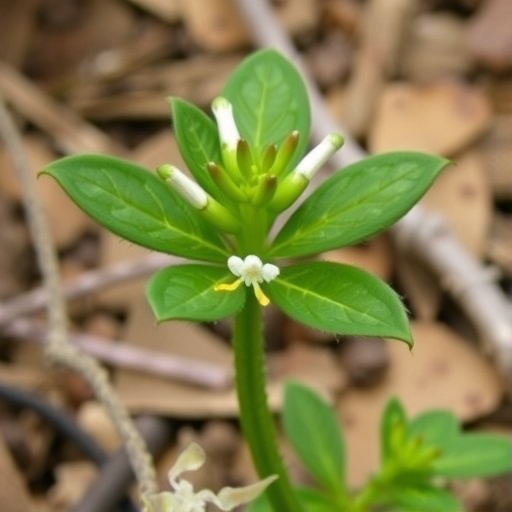Research into the conservation of biodiversity has never been more crucial, as the pressures of climate change and habitat destruction threaten countless species across the globe. Among these species is the endemic orchid, Crepidium manikathilum, a member of the Orchidaceae family found exclusively in the Southern Western Ghats of India. Recent research has unveiled critical insights into the distribution of this captivating orchid, offering a ray of hope amid fears of extinction. This study sheds light on the orchid’s ecological requirements, assesses its status on the IUCN Red List, and explores innovative techniques for its in vitro propagation, thereby contributing significantly to conservation efforts.
The Southern Western Ghats is a UNESCO World Heritage site, celebrated for its unique ecosystem and biodiversity. This region harbors a wealth of flora and fauna, many of which are endemic. The recent findings regarding Crepidium manikathilum underscore its importance as an indicator species, reflecting the health of its environment. The researchers embarked on extensive field surveys, which revealed that this orchid has a more extensive distribution than previously documented. By mapping its range and identifying specific habitats, they have provided vital information that can guide conservation strategies.
One of the pivotal aspects of the research was the IUCN Red List assessment, which is fundamental for the conservation of threatened species. The IUCN (International Union for Conservation of Nature) Red List classifies species based on their extinction risk, using criteria that assess population size, habitat range, and the degree of threat from human activities. The study of Crepidium manikathilum highlights the immediate need for conservation measures, as it faces significant threats from habitat destruction and climate change.
The research team performed a comprehensive survey that included both qualitative and quantitative assessments of the orchid’s populations. They discovered that light availability, soil type, and moisture levels profoundly influence its growth and distribution. By understanding these ecological preferences, conservationists can develop targeted strategies to protect and manage the species’ habitat. This nuanced understanding is vital for creating effective conservation action plans that can address the many threats the orchid faces.
In addition to establishing distribution and ecological requirements, the team also explored innovative methods for propagating Crepidium manikathilum through in vitro techniques. This scientific approach is particularly significant for species that are vulnerable in their natural habitats due to their low reproductive rates and limited dispersal capabilities. In vitro propagation offers a sustainable solution by allowing growers to produce large quantities of plants that can be reintroduced into their native habitats.
The in vitro techniques utilized in this study involve micropropagation, which allows for the rapid multiplication of plant materials under sterile conditions. This method is ideal for preserving genetic diversity and ensuring the survival of Crepidium manikathilum in cultivation. As a result, researchers hope to establish a robust population of these orchids that can be reintroduced into areas where they have become extinct or are on the brink of disappearing.
The findings from this study also carry implications beyond the immediate context of Crepidium manikathilum. They serve as a model for the conservation of other endemic species within the Western Ghats and similar biodiversity hotspots. By adopting a multi-faceted conservation approach that includes habitat preservation, species monitoring, and propagation techniques, efforts can be scaled to protect numerous plant and animal species that share this unique ecosystem.
Moreover, the research reinforces the necessity for a collaborative effort among various stakeholders, including local communities, government agencies, and conservation organizations. Effective conservation is rarely achieved in isolation, and involving local communities is crucial. Their traditional ecological knowledge and vested interest in the preservation of local biodiversity can enhance the success of conservation initiatives.
As the study of Crepidium manikathilum progresses, researchers are also developing outreach programs to educate the public on the importance of orchids and the broader implications for ecological conservation. The aesthetic appeal of orchids often draws attention to these plants, generating interest in their conservation. By harnessing this fascination, outreach efforts aim to inspire action and support for biodiversity protection at both the local and global levels.
Furthermore, integrating technological advancements such as remote sensing and GIS mapping can enhance monitoring efforts and inform conservation strategies. These tools enable researchers to track habitat changes over time, assess threats, and develop adaptive strategies to manage these challenges proactively. The combination of field survey data and technological innovations represents a powerful approach to understanding and conserving threatened species like Crepidium manikathilum.
In conclusion, the multifaceted research on Crepidium manikathilum provides a compelling case for the urgency of conservation efforts in the face of unprecedented environmental change. By documenting the orchid’s distribution, assessing its risks, and exploring innovative propagation techniques, scientists are paving the way toward sustainable conservation practices that can safeguard the future of this exquisite species. The ongoing efforts to protect Crepidium manikathilum not only serve its survival but also underline the broader necessity of maintaining the ecological balance within one of the world’s most biodiverse regions.
This work stands as a testament to the indispensable role of scientific research in informing conservation strategies and highlights the power of collaboration across disciplines and communities to foster a future where biodiversity can thrive.
Subject of Research: Endemic orchid Crepidium manikathilum and its conservation strategies
Article Title: Extended distribution, IUCN redlist assessment and in vitro propagation of endemic orchid Crepidium manikathilum (Orchidaceae) from Southern Western Ghats, India
Article References: Aazhivaendhan, G., Tinoammini, N., Rajasekar, C. et al. Extended distribution, IUCN redlist assessment and in vitro propagation of endemic orchid Crepidium manikathilum (Orchidaceae) from Southern Western Ghats, India. Discov. Plants 2, 301 (2025). https://doi.org/10.1007/s44372-025-00386-y
Image Credits: AI Generated
DOI:
Keywords: Endemic species, Conservation, Orchidaceae, Crepidium manikathilum, Southern Western Ghats, IUCN Red List, In vitro propagation, Biodiversity.




